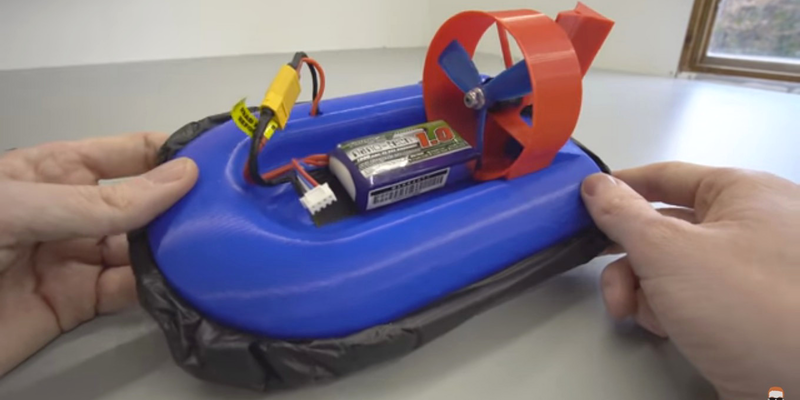RC hovercrafts offer all sorts of design options which make them interesting projects to explore. There are dual-motor ones where one motor provides lift while the other does the thrust. For steering, the thrust motor can swivel or you can place a rudder behind it. And there are single-motor ones where one motor does all the work. In that case, the airflow from the motor blades has to be redirected to under the hovercraft somehow, while also being vectored out the back and steered.
[Tom Stanton] decided to make a single-motor hovercraft using only a single 3D printed piece for the main structure. His goals were to keep it as simple as possible, lightweight, and inexpensive. Some of the air from the blades is directed via ducting printed into the structure to the underside while the remainder flows backward past a steering rudder. He even managed to share a bolt between the rudder’s servo and the motor mount. Another goal was to need no support structure for the printing, though he did get some stringing which he cleaned up easily by blasting them with a heat gun.
From initial testing, he found that it didn’t steer well. He suspected the rudder wasn’t redirecting the air to enough of a sideways angle. The solution he came up with was pretty ingenious, switching to a wedge-shaped rudder. In the video below he gives a the side-by-side comparison of the two rudders which shows a huge difference in the angle at which the air should be redirected, and further testing proved that it now steered great.
Another issue he attacks in the video below was a tendency for the hovercraft to dip to one side. He solves this with some iterative changes to the skirt, but we’ll leave it to you to watch the video for the details. The ease of assembly and the figure-eight drift course he demonstrates at the end shows that he succeeded wonderfully with his design goals.
This is the first 3D printed hovercraft we’ve covered which uses a single motor but we have seen a non-3D printed one before, this screaming fast one made instead out of foam board. And while you’re at it, check out this fiberglass reinforced foam one which looks straight out of a Batman movie.
















This is the coolest thing I’ve seen this guy build. I am impressed at his ability to design such a sophisticated shape in CAD. I also like how he walks through the refinement process. Cool video!
That’s quiet neat.
Interestingly after not seeing much about hovercrafts for years ( I had an RC one 25 years ago) I was at our local show and spied a couple of hovercraft on display. Turned out there is a hovercraft manufacturing company just “round the corner” from me.
http://www.viperhovercraft.com.au
Impressive would be an understatement. Wonderfully designed and executed.
Very nice build and great troubleshooting. But what does one do when their hovercraft is full of eels?
Only a Hungarian cold answer that, probably.
https://www.youtube.com/watch?v=CJa6eUpxNyM
It died on a lake years ago.
RIP TYPHOON
I’ll see your electric and raise you a decade or two earlier (not my video). The engine was pretty marginal so it was never suited for much and would never go over water.
https://youtu.be/EyZ8R4QPPo0
That’s what I had :)
Think it turned out when the rubber skirt disintegrated only a few years ago
Bayliner uses a foam ring so if it sinks it stops at some point. A foam sheet glued under could save it, or you.
Kewl ! Thanks for sharing…
The rudder problems are not so much due to lack of deflection. More of a case of too much (attempted) deflection. What he was experiencing in the first design is rudder stall. Past a certain angle of attack the rudder just loses nearly all effectiveness. With the wedge design the effective AoA of the backside of the rudder is reduced, preventing flow separation and allowing the rudder to remain effective at higher AoAs
Would it not also be more effective if the pivot point was moved further towards the back edge, so that, as the rudder is rotated, the front edge travels further left and right and thus captures more air?